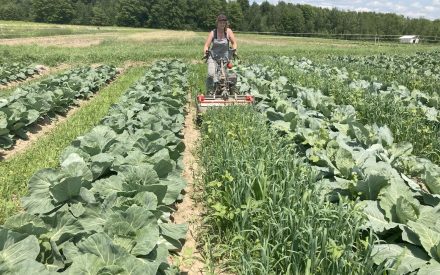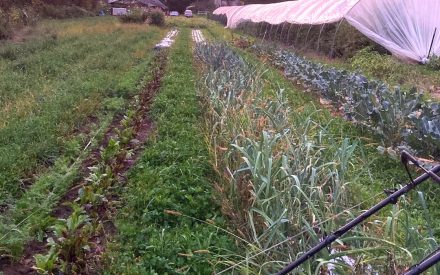Harvesting small grains or processing crops in the summer months provides a great opportunity to plant a variety of cover crop species that can achieve several different benefits or goals such as soil erosion protection, nitrogen (N) supply to subsequent grain crops, and weed suppression.
Given the early harvest of small grains and processing crops across the state, farms in all regions of Wisconsin can capitalize on the benefits of establishing summer covers. Below is a summary of some of the common grass, legume, and brassica cover crop species that the UW recommends.
Table of Contents
Legumes
Legumes are great cover crops to grow in order to supply N to the next crop. Most legume species form symbiotic relationships with rhizobia that “fix” atmospheric N, bringing new N into the cropping system. Legumes have lower C:N ratios compared to other plants, and as a result, will decompose and mineralize rapidly in the spring. It is through this mechanism by which N is supplied to the next crop, lowering the rate of fertilizer that needs to be applied. Research in WI has shown N credits ranging from 40 to 60 lb-N/ac from a well-established winter-killed legume cover crop, with up to over 80 lb-N/ac more from species that do not winter-kill. Ultimately the amount of N supplied by legume cover crops will depend on species, growth, and soil type. Some clovers, such as red clover, are also harvestable as forage. All are good choices for a wheat-corn-soybean grain crop rotation when planted after winter wheat and before corn.
Berseem clover is a fast-growing clover that can quickly provide soil erosion protection and weed suppression. Compared to crimson clover, berseem generally establishes and grows better in wet conditions; however, it doesn’t grow as well as other cover crop species in dry conditions. Berseem clover is normally one of the first species to winter-kill in WI; typically at temperatures near or below 27 degrees.
Crimson Clover also typically winter-kills, but occasionally will survive WI winters. In cases where it has survived through the winter, it has been observed to grow very quickly in the spring. Crimson is slightly more tolerant of dry conditions than berseem.
Field peas are a large-seeded, cool season annual that are commonly grown with a spring cereal grain to encourage climbing and minimize lodging.
Hairy vetch is a legume species that is much more winter-hardy than the berseem and crimson clover species discussed previously. This generally leads to overwintering with additional growth occurring in the spring. Rapid spring growth is common, so be sure to have an effective termination strategy (mechanical, chemical, or combination). Allowing an extended period of spring-growth and delaying termination until very close to subsequent cash crop planting can result in significant control challenges.
Medium red clover is a short-lived perennial that is best companion-planted with spring cereal grains or frost seeded (March-April) into fall established cereal grains (Stute and Shelley, 2006). Red clover is a popular choice to maximize the amount of N benefit, while also having well-known approaches to successful termination.
Legume Management Considerations
The obvious benefit of leguminous cover crops is their ability to supply next year’s cereal crop with N. Other goals of using legume covers might include additional forage harvest or grazing opportunities. When N-supply to following crops or forage production are the primary goals, consider planting a single legume species. If the primary goal is soil erosion reduction, consider planting a mix including species that will not winter-kill to ensure adequate spring residue cover.
Brassicas
Brassicas such as radish are a fast growing cover crop, capable of producing a large taproot that can extend several feet deep if planted in July or August. These radishes are often touted to alleviate soil compaction by “bio-drilling” down through compacted layers within the crop root zone. Research suggests, however, that radish root growth can be restricted by compaction zones and often does not break up compaction. Other brassicas such as turnips and canola, will have similar tap-rooting to radish, with less overall root volume. Turnips typically winter-kill, but depending on the variety, rapeseed will likely survive the winter and require herbicide termination in the spring. Due to a more rapid rate of decomposition, as compared to the grasses, monoculture stands of turnips or radishes often do not provide sufficient residue cover for erosion reduction. Choosing varieties that are slow to bolt and have limited hard seed will reduce the likelihood of volunteer plants during the next growing season. Brassicas should not be planted alone, rather, should be planted in a mixture with grasses or legumes to prevent soil erosion.
Grasses
Grass cover crops are especially great for erosion control as they establish and grow quickly, especially when planted mid-to-late summer. These covers can produce a lot of biomass adding carbon (C) back into the soil through the decomposition of roots, shoots, and aboveground biomass. These sources of C act as an energy source for soil microbes, allowing for enhanced biological activity in soils. Additionally, grass covers tend to scavenge residual N from the soil, potentially reducing fall-through-spring N losses to the environment.
Oats and spring barley will grow rapidly in late summer and continue until a hard freeze (winter-kill). Planted early enough, oats and barley will produce significant amounts of residue prior to the killing frost which will aid in reducing soil erosion the following spring. Barley and oats can also be harvested in the fall as a forage, however this reduces their effectiveness in reducing spring erosion.
Winter rye or winter triticale can be planted August-September for a late summer and over-winter cover; they will survive winters in Wisconsin. Planted in August, winter rye will produce a thick cover in the fall and then will grow rapidly in early spring. Rye and triticale used as cover crops need to be terminated by late April before they grow too large and become difficult to manage. Rye and triticale can also be harvested in the spring as a forage.
Grass Management Considerations
Given the rapid growth of grass cover species, biomass production can “get out of hand” rather quickly if planting occurs too early in the summer. Excessive N tie-up and soil moisture uptake could result in management challenges in subsequent cash crops.
If planting monoculture, grass-based cover crops, consider these options to avoid excessive biomass production:
- Delay planting window to late-August through mid-September;
- If planting prior to late-August, consider reducing seeding rate;
- Plant a cover crop mixture with grass, brassica, and legume species included.
For over-wintering species, be sure to stay on top of termination timing leading up to the planting of your cash crop. For corn, grass species such as winter rye should be terminated 1-2 weeks prior to planting. Soybeans, however, can be planted green into standing rye with termination occurring shortly thereafter.
Cover Crop Mixtures
Cover crop mixtures can be used following small grains or processing crops to achieve multiple benefits. For example, planting a mixture of a legume and an overwintering grass can both supply N to the next crop and provide erosion control in the spring. Examples of feasible cover crop mixtures, including seeding rates, dates, and depths, can be found in Table 1 of USDA-NRCS Wisconsin Agronomy Technical Note 7 (Cover and Green Manure Crops Benefits to Soil Quality).
When deciding on a cover crop species or mixture, always consider what your cover crop goals are (e.g. nitrogen production for next year’s corn, soil protection, weed suppression, etc.), as well as your system and potential equipment limitations, prior to purchasing and planting. For more information, see the additional cover crop resources listed below and reach out to your local Extension educator or specialist if you have any questions.
Additional Cover Crop Information
EARLY SPRING and SUMMER Cover Crop Options for Wisconsin Cropland
UW–Madison Extension Crops and Soils Cover Crop Resources Page
Integrated Pest and Nutrient Management Cover Crops Resource Page
Herbicide Rotational Restrictions for Cover and Forage Cropping Systems
Cover Crops and Annual Forages
Quantifying the benefits of legume cover crops following winter wheat

 Living Aisles Case Study #1: Sawyer Farm, Worthington, MA & Momentum Ag
Living Aisles Case Study #1: Sawyer Farm, Worthington, MA & Momentum Ag Living Aisles Case Study #2: Gorman Farm, Fitchburg, WI
Living Aisles Case Study #2: Gorman Farm, Fitchburg, WI Living Aisles Case Study #3: Red Door Family Farm, Athens, WI
Living Aisles Case Study #3: Red Door Family Farm, Athens, WI Living Aisles Case Study #4: Circadian Organics, Ferryville, WI
Living Aisles Case Study #4: Circadian Organics, Ferryville, WI


